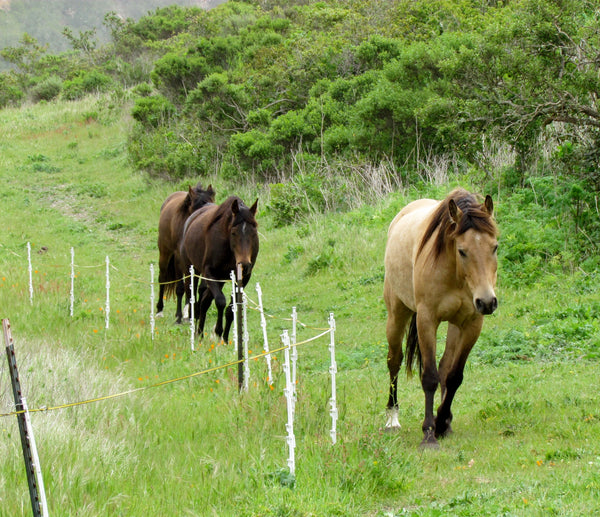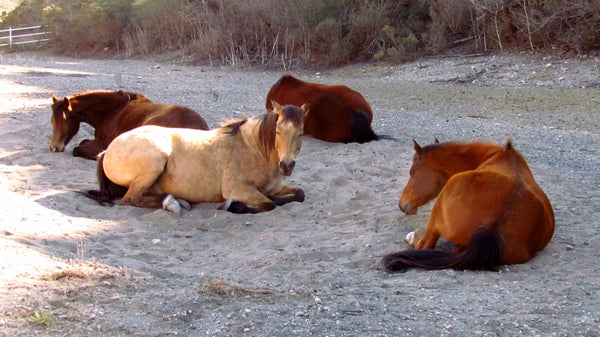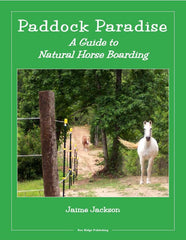Welcome to Paddock Paradise!

Paddock Paradise (frequently referred to as 'a track system') is a 'management practice and/or boarding concept' based on the environment and the lifestyles of the sound, healthy, wild and free-roaming horses living naturally in the U.S. Great Basin (an adaptive habitat). It was conceived as a way for horse owners to provide domestic equines with an environment that more closely resembles their natural habitat in order to prevent laminitis and to achieve optimal health.. It was not until Jaime Jackson published the book, Paddock Paradise: A Guide to Natural Horse Boarding, that the concept of providing horses with anything other than a paddock, pasture, stable or field had ever been discussed.
Click here to see our official Paddock Paradise website.

by Luca Gandini
According to research and studies conducted by the author (natural hoof care and wild horse expert, Jaime Jackson), bands of (horse) family members move along familiar routes or tracks as they travel great distances to different places in their various territories. Because horses are animals of prey, they instinctively move in close (single-file) formation across these home ranges as they seek out various destinations for forage, water, rolling spots, other herds with whom they wish to interact and other activities essential to their biology and survival.

By providing them with tracks, we can trigger this instinct to move and stimulate more natural movement as well. They quickly reveal their desire to use these tracks by creating narrow, worn down paths—just like in wild horse country— where travel to a new destination or forward movement is the sole purpose or activity.

Wild, free-roaming horses in Nevada by Phillip Adams
 photo by Jill Willis
photo by Jill Willis
The principal goal of PP is to facilitate optimal health and soundness - both physical and mental - in our horses. In fact, it is an ideal preventative to many of the common illnesses and disorders plaguing domestic equines who are forced to live in stalls or other forms of isolation and/or close confinement or, equally hazardous, in lush, sugar-laden grass pastures. In fact, a genuine PP can virtually eliminate the risk of laminitis, colic, Navicular Syndrome and other debilitating conditions caused by an unnatural lifestyle and diet. As well, it allows horses to eat as they do in nature - on the move!

Due to the threat of predation, horses rarely linger in a 'lush grassy area' in the wild for long but may grab a few bites here and there and then continue on their travels up to 25 miles per day. A more natural manner to feed horses is to provide free access to grass hays - strategically placed in 'feeding stations' around the track to encourage movement and, ideally, various bushes, trees, shrubs, herbs, wildflowers, (etc) with very limited grass unless the pasture is one in their native biome. And even then, without the threat of predators, it should be carefully watched or limited in order to avoid levels of saturation that can result in laminitis.

A PP will encourage movement even on small acreages - GPS anecdotal research indicates far more movement from horses after a PP track system has been installed compared to movement in a pasture.. It allows horses to live more closely to the manner nature intended, moving freely 24/7 and eating in a more natural way by having constant access to the right kinds of food placed strategically throughout their track. The image below was taken within days of the installation of the track fencing and there was still far too much 'green.'

Creating a Paddock Paradise can be fairly simple and inexpensive. An electric fence ‘loop’ can be installed just inside a perimeter fence and surround a pasture or field like the diagram at left. When horses are allowed to live in a manner that more closely resembles their natural habitat, not only are they healthier but also happier!

Paddock Paradise: A Guide to Natural Horse Boarding was written by Jaime Jackson and first published in 2007.
For additional information, please visit our Instagram (@paddockparadise_official) and Facebook pages (@Officialpaddockparadise)
Most major online retailers carry this and other books by Jaime Jackson (www.target.com, www.walmart.com, www.bookdepository.com, www.amazon.com, www.amazon.co.uk, etc.) And most libraries will order any book you request.
Photos by Jill Willis are from the Paddock Paradise at the joint field headquarters of the Association for the Advancement of Natural Horse Care Practices in Lompoc, CA (www.AANHCP.net) and the ISNHCP (Institute for the Study of Natural Horse Care Practices). If you are interested in a consultation in order to set one up on your own, please go to www.jaimejackson.com or email Jill Willis (kjillwillis@gmail.com) for more information. Others are just a few images of Paddock Paradises from around the world.
Paddock Paradise: A Guide to Natural Horse Boarding has been translated into German, Danish, French, Czech and Russian.
 Paddock Paradise at Blue Star Equiculture in Palmer, Massachuesetts
Paddock Paradise at Blue Star Equiculture in Palmer, Massachuesetts
 Paddock Paradise in Finland
Paddock Paradise in Finland
 Paddock Paradise in Canada
Paddock Paradise in Canada
 Paddock Paradise in Czech
Paddock Paradise in Czech
 Paddock Paradise in Normandy, France
Paddock Paradise in Normandy, France
 Paddock Paradise in Arizona
Paddock Paradise in Arizona
 Paddock Paradise in Madison, Wisconsin
Paddock Paradise in Madison, Wisconsin
 Paddock Paradise in Moncalvo, Italy
Paddock Paradise in Moncalvo, Italy
 Paddock Paradise in Denmark
Paddock Paradise in Denmark
 Paddock Paradise in Germany
Paddock Paradise in Germany
 Paddock Paradise in Kauai, Hawaii
Paddock Paradise in Kauai, Hawaii

 Paddock Paradise at de Paardenmaat boarding facility in the Netherlands
Paddock Paradise at de Paardenmaat boarding facility in the Netherlands
 Paddock Paradise at Worthy Soles Retirement in Tehachapi, California
Paddock Paradise at Worthy Soles Retirement in Tehachapi, California
 Paddock Paradise in Australia
Paddock Paradise in Australia
 Paddock Paradise in England
Paddock Paradise in England
 Paddock Paradise in Portugal
Paddock Paradise in Portugal
 Paddock Paradise in Tennessee
Paddock Paradise in Tennessee

